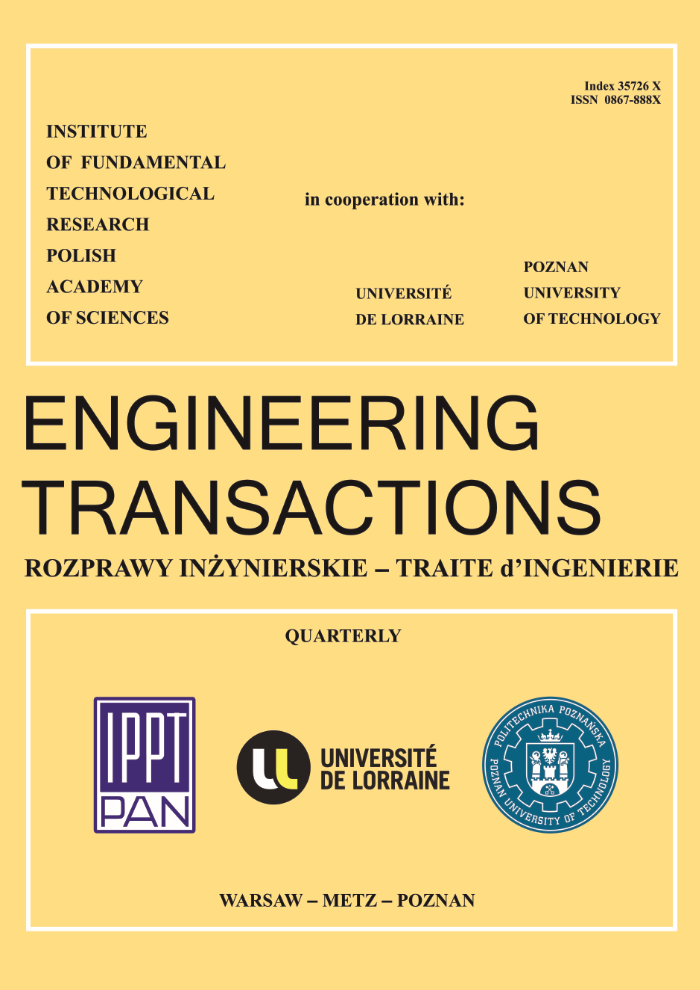Abstract
The paper describes a computer analysis of the pull-out test used to determine the force needed to pull out a fragment of rock and the shape of this broken fragment. The analyzed material is sandstone and porphyry. The analysis included a comparison of different methods of propagation of cracks in the Abaqus computer program using the Finite Element Method. The work also contains a description of laboratory tests and analytical considerations.Keywords:
pull-out test, rock mechanics, fracture mechanics, numerical modeling of fractureReferences
1. European Technical Assessment ETA-99/0009 of 06/01/2015 for Hilti HDA and HDA-R anchor.
2. Contrafatto L., Cosenza R., Behaviour of post-installed adhesive anchors in natural stone, Construction and Building Materials, 68: 355–369, 2014, https://doi.org/10.1016/j.conbuildmat.2014.05.099.
3. Upadhyaya P., Kumar S., Pull-out capacity of adhesive anchors: An analytical solution, International Journal of Adhesion and Adhesives, 60: 54–62, 2015, https://doi.org/10.1016/j.ijadhadh.2015.03.006.
4. Tistel J., Grimstad G., Eiksund G., Testing and modeling of cyclically loaded rock anchors, Journal of Rock Mechanics and Geotechnical Engineering, 9(6): 1010–1030, 2017, https://doi.org/10.1016/j.jrmge.2017.07.005.
5. Barenblatt G.I., The mathematical theory of equilibrium of crack in brittle fracture, Advances in Applied Mechanics, 7: 55–129, 1962, https://doi.org/10.1016/S0065-2156(08)70121-2.
6. Bower A.F., Applied mechanics of solids, CRC Press, 2010.
7. Elices M., Guinea G.V.G., Gómez J., Planas J., Gomez J., The cohesive zone model: advantages, limitations and challenges, Engineering Fracture Mechanics, 69(2): 137–163, 2002.
8. Brown W.F., Srawley J.E., Plane Strain Crack Toughness Testing of High Strength Metallic Materials, Philadelphia: ASTM International, 1966.
9. van Mier J.G.M., Fracture processes of concrete, CRC Press, 1996.
10. Hasanpour R., Choupani N., Mixed-mode study of rock fracture mechanics by using the modified arcan specimen test, International Journal of Geotechnical and Geological Engineering, 2(5): 716–721, 2008.
11. Gontarz J., Podgórski J., Explanation of the mechanism of destruction of the cylindrical sample in the Brazilian test, [in:] Advances in mechanics : theoretical, computational and interdisciplinary issue, [Eds: Kleiber M., Burczyński T., Wilde K., Górski J., Winkelmann K., Smakosz Ł.] ,pp. 479–483, Boca Raton, Gdańsk 2016,
12. Goodier J.N., Compression of rectangular blocks, and the bending of beams by non-linear distributions of bending forces, J. Appl. Mech., 54(18): 173–183, 1932.
13. Mohammadi S., Extended finite element method: for fracture analysis of structures, Wiey-Blackwell, 2008.
14. Jirasek M., Zimmermann T., Embedded crack model. Part II: Combination with smeared cracks, International Journal for Numerical Methods in Engineering, 50(6): 1291–1305, 2001, https://doi.org/10.1002/1097-0207(20010228)50:6.<1291::AID-NME12>3.0.CO;2-Q.
15. Tejchman J., Bobiński J., Continuous and discontinuous modelling of fracture in concrete using FEM, Springer-Verlag, 2013, https://doi.org/10.1007/978-3-642-28463-2.
16. Abaqus V 6.14.2 Users Manual, 2014.
17. Bazant Z. P., Kazemi M. T., Hasegawa T., Mazars J., Size effect in Brazilian split-cylinder tests. Measurements and fracture analysis, ACI Materials Journal, 88(3): 325–332, 1991.
18. Podgórski J., The criterion for determining the direction of crack propagation in a random pattern composites, Meccanica, 52(8): 1923–1934, 2017, https://doi.org/10.1007/s11012-016-0523-y.
2. Contrafatto L., Cosenza R., Behaviour of post-installed adhesive anchors in natural stone, Construction and Building Materials, 68: 355–369, 2014, https://doi.org/10.1016/j.conbuildmat.2014.05.099.
3. Upadhyaya P., Kumar S., Pull-out capacity of adhesive anchors: An analytical solution, International Journal of Adhesion and Adhesives, 60: 54–62, 2015, https://doi.org/10.1016/j.ijadhadh.2015.03.006.
4. Tistel J., Grimstad G., Eiksund G., Testing and modeling of cyclically loaded rock anchors, Journal of Rock Mechanics and Geotechnical Engineering, 9(6): 1010–1030, 2017, https://doi.org/10.1016/j.jrmge.2017.07.005.
5. Barenblatt G.I., The mathematical theory of equilibrium of crack in brittle fracture, Advances in Applied Mechanics, 7: 55–129, 1962, https://doi.org/10.1016/S0065-2156(08)70121-2.
6. Bower A.F., Applied mechanics of solids, CRC Press, 2010.
7. Elices M., Guinea G.V.G., Gómez J., Planas J., Gomez J., The cohesive zone model: advantages, limitations and challenges, Engineering Fracture Mechanics, 69(2): 137–163, 2002.
8. Brown W.F., Srawley J.E., Plane Strain Crack Toughness Testing of High Strength Metallic Materials, Philadelphia: ASTM International, 1966.
9. van Mier J.G.M., Fracture processes of concrete, CRC Press, 1996.
10. Hasanpour R., Choupani N., Mixed-mode study of rock fracture mechanics by using the modified arcan specimen test, International Journal of Geotechnical and Geological Engineering, 2(5): 716–721, 2008.
11. Gontarz J., Podgórski J., Explanation of the mechanism of destruction of the cylindrical sample in the Brazilian test, [in:] Advances in mechanics : theoretical, computational and interdisciplinary issue, [Eds: Kleiber M., Burczyński T., Wilde K., Górski J., Winkelmann K., Smakosz Ł.] ,pp. 479–483, Boca Raton, Gdańsk 2016,
12. Goodier J.N., Compression of rectangular blocks, and the bending of beams by non-linear distributions of bending forces, J. Appl. Mech., 54(18): 173–183, 1932.
13. Mohammadi S., Extended finite element method: for fracture analysis of structures, Wiey-Blackwell, 2008.
14. Jirasek M., Zimmermann T., Embedded crack model. Part II: Combination with smeared cracks, International Journal for Numerical Methods in Engineering, 50(6): 1291–1305, 2001, https://doi.org/10.1002/1097-0207(20010228)50:6.<1291::AID-NME12>3.0.CO;2-Q.
15. Tejchman J., Bobiński J., Continuous and discontinuous modelling of fracture in concrete using FEM, Springer-Verlag, 2013, https://doi.org/10.1007/978-3-642-28463-2.
16. Abaqus V 6.14.2 Users Manual, 2014.
17. Bazant Z. P., Kazemi M. T., Hasegawa T., Mazars J., Size effect in Brazilian split-cylinder tests. Measurements and fracture analysis, ACI Materials Journal, 88(3): 325–332, 1991.
18. Podgórski J., The criterion for determining the direction of crack propagation in a random pattern composites, Meccanica, 52(8): 1923–1934, 2017, https://doi.org/10.1007/s11012-016-0523-y.







